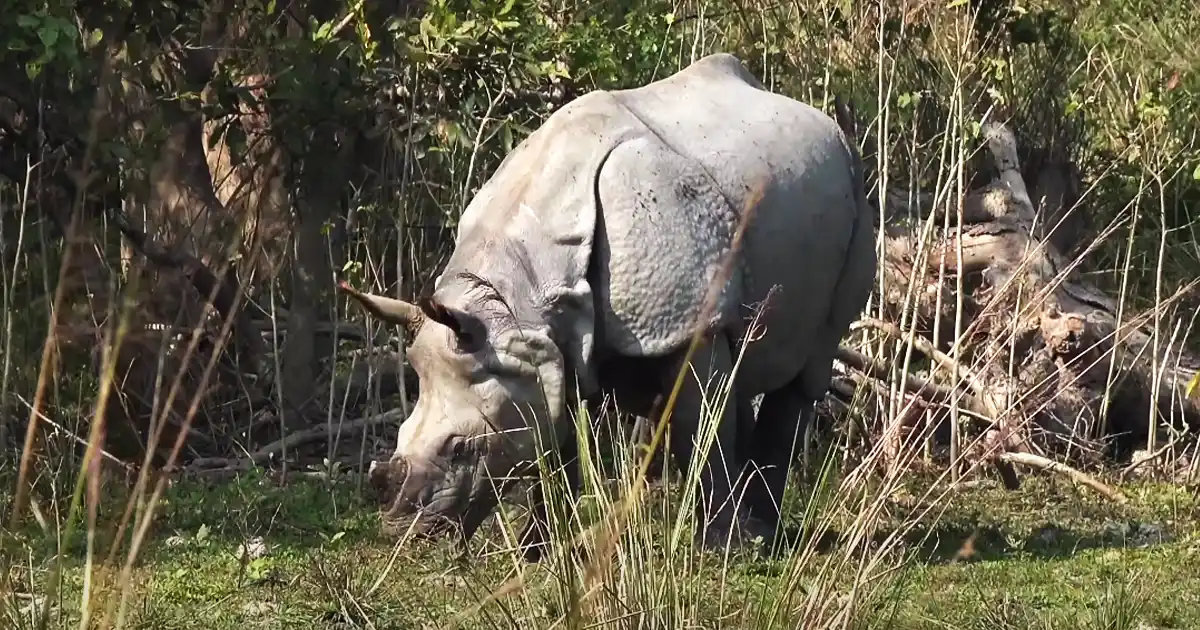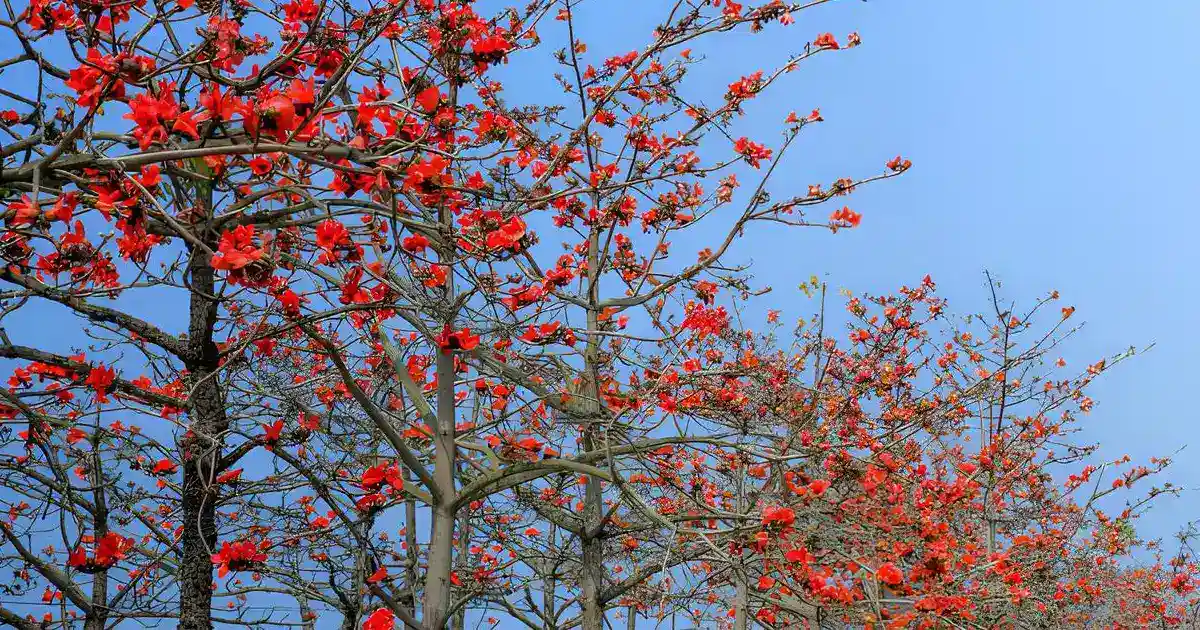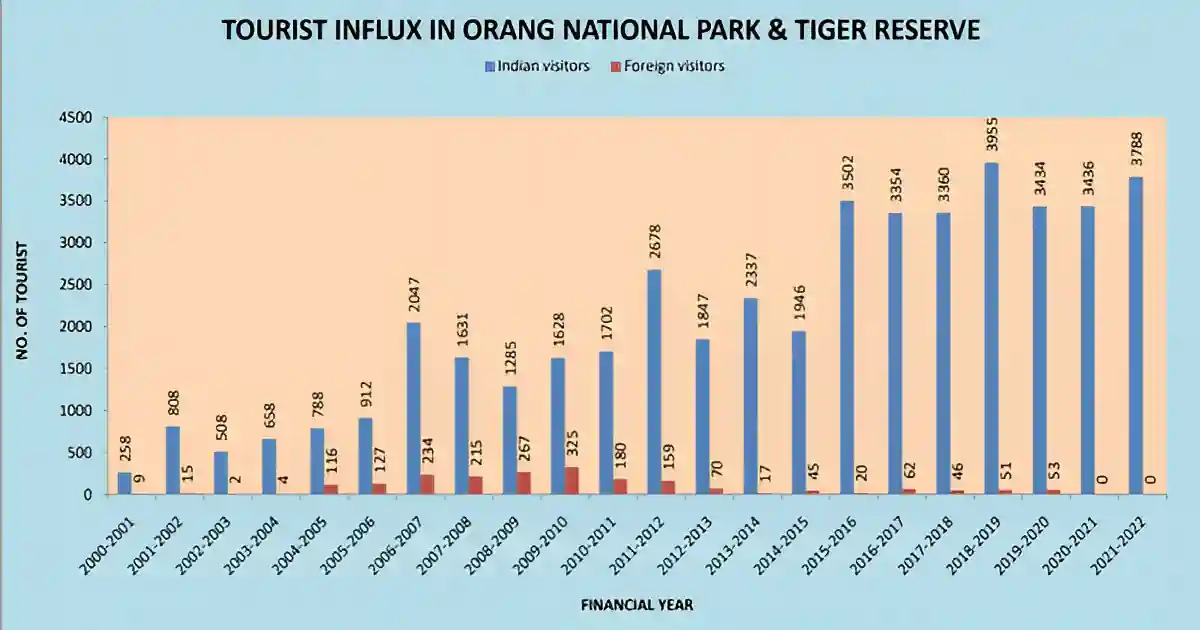The core area of the Orang National Park is 78.82 located within the 279.60 sq. Km of the Orang Tiger Reserve. The Park is called “mini Kaziranga” due to its similar landscape of streams, grassland, and swamplands of Kaziranga National Park. The park boasts a variety of species such as One-Horned Rhino, elephants, wild buffalo, pigmy hog, deer, tigers, and many others. Census conducted from March 19th to March 21st, 2022 in Orang National Park counted 125 one-horned rhinos. There are 43 males, 49 females, 23 calves and 10 unidentified, which increased by 24 percent since the last census in 2018.
Where is Orang National Park Location
The Orang National Park is located within 279.60 Sq. Km core area of the Orang Tiger Reserve in the districts of Sonitpur and Darrang in Assam, India. It is sited in the northern parts of the Brahmaputra River. The Orang National Park is 40 km. from Tezpur and 140 km. from Guwahati. The park is coordinates Latitude 26º 29′ N and 26º 40′ N, Longitude 92º 15′ E and 92º 27′ E.
Location, Area, Name, and Administration
1. District: Darrang and Sonitpur
2. Sub-Division: Mangaldai and Tezpur
3. Revenue Circle: Dalgaon in Darrang District, Dhekiajuli and Thelamara in Sonitpur District
4. Forest Division: Mangaldai Wildlife Division
5. Range: Orang National Park, Silbori, Darrang
6. Total area of Orang Tiger Reserve including Buffer: 504.23 Sq. Km.
7. Core Area: 279.60 Sq. Km.
8. Buffer Area: 224.63 Sq. Km.
9. Administration: The park is under the jurisdiction of the Range Officer, Orang National Park, Silbori. The DFO, Mangaldai Wildlife Division functions as the Field Director of the park assisted by an ACF and a Range Officer. There are 40 anti-poaching camps in the national park.
The buffer area surrounding the park has no reserve forests or protected areas. It is primarily inhabited by humans and consists of agricultural land, trees, tea estates, bamboo, ponds, river and wetlands.
Orang National Park Map and Boundary
The boundary of Orang National Park is surrounded by inhabited villages thus it is subject to biotic anthropogenic pressure.
On 25th August 2022, the Governor of Assam through an official notification vide number FRW.14/2004/Pt/64 extended the area of Orang National Park from 78.82 sq. km to 299.14 sq. km.
East: The Eastern boundary of Orang National Park extended up to the Gupteswar Temple at Singori in the Sonitpur district and touches the western boundary of Burhachapori Wildlife Sanctuary. The starting from GPS point 26°36’56.06’’N; 92°34’38.20’’E to GPS point 26°32’58.69’’N; 92°37’43.57’’E.
South: The southern boundary extended up to the district border of Morigaon and Nagaon districts. The starting from GPS point 26°32’58.69’’N; 92°37’43.57’’E to GPS point 26°25’31.19’’N; 92°13’44.92’’E.
West: The western boundary of the park extended up to Shyampur Police Station in the Darrang district and Morigaon district border. The starting from GPS point 26°25’31.19’’N; 92°13’44.92’’E to GPS point 26°28’41.14’’N; 92°13’0.37’’E.
North: The Northern boundary of Orang National Park shares a boundary of village roads and extended from the western boundary GPS point 26°28’41.14’’N; 92°13’0.37’’E to starting GPS point of the eastern boundary 26°36’56.06’’N; 92°34’38.20’’E.
The extension of Orang National Park becomes a connectivity corridor for transient and resident animals including tigers, rhinos and elephants across a 180 km long Brahmaputra riverine area from the west of Orang National Park to the east of Kaziranga National Park.
Orang National Park Chronology
1880-1900: Earlier the park was inhabited by the local ethnic tribes from 1880 to 1900. But the black water fever epidemic disease forced the tribal population to abandon the area.
1915: British colonial authorities first declared Orang National Park as Orang Game Reserve with an area of 80.54 km2 in 1915 through vide notice No. 2276/R dated 31.05.1915. A Beat Office Under Mazbat Range of Darrang Division, Tezpur was established.
1931: A 17.29 km2 area in the northern part of the Sanctuary was de-reserved for settling immigrants from Mymensingh district (now Bangladesh) under the Grow More Food Scheme. Additionally, 8.73 km2 of land to the east of Panchnoi River was annexed for plantation.
1931-41: A plantation under the Taungya System in the Bors Working Plan was started but failed.
1942-52: Under Jacob’s Plan (Taungya System) Plantation of softwood species was taken up.
1952-61: The plantation of Softwood species continued.
1961: To continue planting softwood species extensively the area was handed over to Mangaldai Range (Hojai Afforestation Division).
1962-1972: The area was recommended under M.M. Islam’s Plan for Conservation for its wildlife values.
1972: The area was handed over to the Wildlife Wing on November 1, 1972, and designated as an Auxiliary Area for Project Tiger following the ban on hunting in 1972.
1985: On 20th September 1985, the area covering 75.60 km2 was notified as Wildlife Sanctuary vide notification No. FRS 133/85/5 dated 20 September 1985. 1st Rhino census was conducted.
1991: On 21st February 1991 by evicting encroachers on khas (Government land) an area of 3.21 km2 was added on the western side. 2nd Rhino census was conducted.
1992: The Orang wildlife sanctuary was renamed as Rajiv Gandhi Wildlife Sanctuary, but public pressure against the renaming led to its reversal.
1998: On 17th March 1998, the Governor of Assam through vide notification No. FRW 28/90/116 dtd.17/03/1998 declared the boundary schedule of Orang wildlife sanctuary covering an area of 7880.792 hectors (approx.)
Location:
1. District (Civil) –Darrang (Part), Sonitpur (Part)
2. Forest Division –Mangaldai Wildlife Division
3. Sub-division (Civil) –Udalguri (Part), Tezpur (Part)
4. Circle (Civil –Dalgaon (Part), Dhekiajuli (Part)
5. Area –7880.792 hector (approx.)
6. Name of Wildlife Sanctuary- Orang wildlife sanctuary
1999: On 13th April 1999, the Governor of Assam notified the Orang wildlife sanctuary as Orang National Park vide notification No. FRW/28/90/154 dtd.13/04/1999. There is no change to the area and boundary of the schedule which was already notified as a wildlife sanctuary vide notification no. FRW 28/90/116 dtd.17/03/1998.
2016: Notification of Orang Tiger Reserve (the 49th Tiger Reserve of India)
On 24th February 2016, as per the approval by the National Tiger Conservation Authority, Government of India vide its letter F.No.151(7)/2015-NTCA dated 18.08.2015, the Governor of Assam vide notification no. FRW.14/2004/34 dated 24/02/2016 declared the area described in the schedule below as Orang Tiger Reserve and become the 49th Tiger Reserve of India.
Location, Area and Name
1. District (Civil) –Darrang and Sonitpur
2. Forest Division –Mangaldai Wildlife Division
3. Sub-division (Civil) -Mangaldai and Tezpur
4. Revenue Circle (Civil –Dalgaon, Thelamara and Dhekiajuli
5. Name –Orang Tiger Reserve
6. Core Area –79.28 sq. km
7. Buffer Area -413.18 sq. km
8. Total Area –492.46 sq. km
Description of Orang Tiger Reserve boundary
Core Area: The existing vide notification no. FRW.28/90/154 dtd.13/04/1999 & FRW. 06/2010/12 dtd.28.10.2010 of Orang National Park.
Buffer Area:
- East: Eastern buffer area touches the western boundary of Burachapori Wildlife Sanctuary.
- South: The Brahmaputra River forms the southern buffer boundary starting from GPS point 92.628°E, 26.550°N in the east to the GPS point 92.255°E, 26.430°N in the west.
- West: GPS coordinates: 92.217°E, 26.505°N, Location: Western direction of the Hazarbigha camp, Orang Tiger Reserve.
- North: GPS coordinates: 92.338°E, 26.624°N, Location: Northern direction of Kachariveti camp, Orang Tiger Reserve.
2022: On 10th June 2022, the governor of Assam vide notification no. FRW.14/2004/212 annexed 47 hectares as 1st Addition of Orang National Park & Tiger Reserve.
2022: Again, On 25th August 2022, the governor of Assam vide notification no. FRW.14/2004/pt./64 annexed 200.32 sq. km as 2nd Addition of Orang National Park.
Orang National Park Encroachment and Conservation
In 1991, Orang National Park faced severe threats from human activities. Illegal land occupation, encroachment, farming and resource extraction by immigrants and local peoples led to rampant poaching causing a drastic decline in the rhino population from 97 to just 48.
To tackle this issue, anti-poaching measures were taken and a “Coordination Committee” was formed to coordinate efforts from Darrang, Sonitpur and the Marigaon districts including officials from the Forest Department of Assam. By undertaking anti-poaching measures their numbers increased to 68 in 2006-2007 from 48 in 1991.
WAZA, WWF India, the Government of Assam, IRF and Zoo Basel (Switzerland) initiated the project titled “Rhino Vision India (RVI)” to increase the number of rhinoceros and tigers.
With the objective of improving the genetic diversity of managed animal populations, the WAZA institutions and Busch Gardens have launched a conservation program called the Species Survival Plan (SSP).
The project “Ecological Monitoring of Wild Tigers in Orang National Park, Assam, India,” has been launched under this program in association with AARANYAK, an NGO in India. Local researchers use camera traps and geospatial technology to monitor tiger density in the park. Community participation to help manage, mitigate and prevent conflict between humans and tigers is also part of the conservation plan.
Wildlife Statistic of Orang National Park
| Sl. | Wildlife | 1985 | 1991 | 1999 | 2006 | 2007 | 2009 | 2011 | 2012 | 2017 | 2018 | 2022 |
| 1 | Elephant | 7 | 7 | 4 | 4 | 4 | ||||||
| 2 | Pygmy Hog | 120 | ||||||||||
| 3 | Rhino | 65 | 97 | 46 | 68 | 64 | 100 | 101 | 125 | |||
| 4 | Tiger | 24 |
Orang National Park Geography
The Orang National Park is formed by sedimentary floodplains of several rivers including the Brahmaputra River and its tributaries in Darrang and Sonitpur districts. It boasts a unique geography with a gently sloping flat terrain extending from north to south. The park is elevated from 55 meters to 90 meters above the mean sea level to the north. It is surrounded by islands and spill channels of the river towards its south and east.
The park has two distinct alluvial terraces: a newer lower portion along with the Brahmaputra River to the south and an older upper portion to the north. These terraces are separated by a prominent east-to-west running high bank.
The Belsiri River, Pachnoi River and Dhanshiri River bordering the park join with the Brahmaputra. In the monsoon season, Orang National Park transforms into a vast floodplain where multiple streams overlap each other. These flood plains create twelve wetlands apart from the twenty-six artificial water bodies in the park.
The terrain of Orang National Park has been classified into different types.
| Terrain Type | Area (sq. km) | Area (sq. mi) |
| Eastern Himalayan moist deciduous forest | 15.85 | 6.12 |
| Eastern seasonal swamp forest | 3.28 | 1.27 |
| Eastern wet alluvial grassland | 8.33 | 3.22 |
| Savannah grassland | 18.17 | 7.02 |
| Degraded grassland | 10.36 | 4.00 |
| Bodies of water | 6.13 | 2.37 |
| Moist sandy area | 2.66 | 1.03 |
| Dry sandy area | 4.02 | 1.55 |
Orang National Park Weather
Orang National Park experiences distinct seasonal variations throughout the year.
- Pre-monsoon (Mar-May): It is the transitional period between the dry winter and the hot summer. During this time temperature rises rapidly reaching maximums of 32ºC and minimums 20ºC. The average rainfall is approximately 400 mm while the average humidity stands at 67%.
- Monsoon (Jun-Sep): It is the rainy season with heavy rainfall occurs of around 1100 mm. The average temperature during the period reached a maximum of 36ºC and a minimum of 23ºC respectively. The average humidity is 82%.
- Retreating Monsoon (Oct-Nov): During this period the temperature falls and fog appears. The average maximum temperature is 29ºC and the minimum temperature is 16ºC. The average rainfall is 120 mm and the relative humidity is 80%.
- Winter (Dec-Feb): This season is cool weather and fog appears. The average maximum temperature is 25ºC and the minimum temperature is 7ºC. The average rainfall is 40-50 mm and relative humidity is 63%.
- Wind speed pattern and distribution: The wind speeds are not high in the park throughout the year. From February to June the winds attained a speed of 2.4 km/hr. with a maximum of 5 km/hr. During the remaining part of the year, the atmosphere is very calm with less wind.
Flora and Fauna of Orang National Park
1. Flora
Orang National Park is rich in the vegetation of forests, grasses, and aquatic and non-aquatic plants. The area was planted with softwood species covering an area of 9.83 km2 under Jacob’s Plan (1942-1952), during 1952-62, and MM Islam’s Plan (1962-77).
Forest species found in the park: Bombax ceiba, Dalbergia sissoo, Zizyphus jujuba, Trewia nudiflora, Sterculia villosa and Litsea monopetala.
Non-aquatic grassland species in the park are Phragmites karka, Imperata cylindrica, Arundo donax and Saccharum spp.
Aquatic grasses and plants found in the park: Andropogon spp., Nymphaea spp., Ipomoea aquatica, Nymphaea spp., Enhydra fluctuans and Water hyacinth (Eichhornia spp.).
2. Fauna
2.1 Mammals: The key species of conservation importance in Orang National Park are Rhinoceros, Tiger, Bengal Florican, Pygmy Hog, and Swamp Francolin. 24 mammalian species including the Royal Bengal tiger, great Indian one-horned rhinoceros, Asiatic elephant, hog deer, wild pig, etc. are some of the mammals found in Orang National Park.
The census conducted in 2017 reported 7 Asian Elephants, 7 Tigers, and 120 Pygmy Hogs in the park. Census conducted from March 19th to March 21st, 2022 counted 125 one-horned rhinos which increased by 24 percent since the last census in 2018 was 101.
As per the IUCN listing the mammalian species found in Orang National Park can be categorized based on their conservation status.
Endangered species: Asian Elephant, Tiger, Gangetic Dolphin, Chinese Pangolin, Bengal Porcupine, Small Indian Civet, Jungle Cat, Smooth-Coated Otter, Hog deer, Wild pig, Rufous-tailed Hare, Wild Buffalo, Fishing Cat, and Small Indian Mongoose are classified as endangered in Orang National Park.
Vulnerable Species: The Indian One-Horned Rhinoceros and Hog Badger are classified as Vulnerable in Orang National Park.
Least Concerned: The Golden Jackal, Rhesus macaque, Bengal Fox, Asian Palm Civet, Indian Hare, Indian Flying Fox, Himalayan Crestless Porcupine, and Leopard Cat are considered Least Concerned in terms of their conservation status.
2.2 Avian fauna: Orang National Park is rich in avian species. So far, 284 resident and migratory bird species have been recorded in the park by direct sighting by the park management and nature enthusiasts. some of which are: the spot-billed pelican, great white pelican, black-necked stork, greater adjutant stork, lesser stork, ruddy shelduck, gadwall, brahmin, mallard, pintail, hornbills, Pallas’s fish eagle, kingfisher, and woodpecker
The milky American white pelican migratory birds have also been reported in the park.
A total of 30−40 Bengal florican was recorded in the park by the Bombay Natural History Society (BNHS) in 1990. As of 2023, Orang National Park has one percent in excess of the global total population of Bengal floricans.
2.3 Reptiles: Orang National Park’s habitats provide food resources and nesting sites for chelonian reptiles. A total of 12 species of turtle, 8 from the Bataguridae family and 4 from the Trionychidae family are found in seven different habitats in the park.
Among the reptiles Pythons, king cobras, Indian rock pythons, monitor lizards, etc. are common.
2.4 Fishes: Orang National Park has recorded more than 50 species of fish in the river and channels flowing through the park.
2.5 Amphibia: Three species of anuran amphibians Kalophrynusorangensis, Kaloula sp. and Microhyla sp. were reported in Orang National Park in 2002.
Best time to visit Orang National Park
The best time to visit Orang National Park & Tiger Reserve is from November to April. During this period the weather is pleasant, wildlife sightings are more likely and an ideal time for bird watching. The park’s lush landscapes and increased accessibility make it a great destination for nature lovers. It is closed during the monsoon season from May to October due to heavy rainfall.
How to reach the Orang National Park
1. By Air – Nearest airport is Tezpur Airport about 60.5 KM from Orang Tiger Reserve main gate. Tezpur airport is well connected by NH15 to Orang National Park. Guwahati Airport is about 138 KM from Orang Tiger Reserve main gate and major connecting road network is NH15.
2.By Rail – The nearest railway station from Guwahati to Orang National Park is Rowta Bagan Railway Station (RWTB) which takes about 3hr 20min to reach the station. RWTB is 36.3km away from the Orang Tiger Reserve main gate and takes 1hr by taxi.
3.By Road – Orang National Park & Tiger Reserve is well connected road network NH27 and NH15 to Major Cities and Places. The distance from Guwahati to Orang National Park main gate is 133 km via NH15 and it takes around 3 hr 35 min to reach the park by taxi. Another route NH27 is approximately 175 km long and takes about 4 hours to reach the park by taxi.
Where to Stay?
There is a tourist lodge available with a maximum accommodation capacity of 16 people maintained by the forest department. Prior reservations are required to stay at the tourist lodge.
There is also forest dormitory available for accommodation upto 40 people without bedding and food near the main gate of Orang National Park.
There are many Private hotels and guest houses are also available in Tezpur which is 60km distance from the Orang National Park.
Orang National Park Safari
Both elephant safari and jeep are available at the Orang National Park & Tiger Reserve. The Forest Department manage either a jeep or elephant safari for the tourists. The charges for safari vary depending on the season.
The rates for different types of safaris are shown below:
Conclusion
Orang National Park’s journey from its historical human habitats to its current status as a national park & tiger reserve showcases its commitment to wildlife conservation. By safeguarding its wildlife and ecosystems, Orang National Park contributes to biodiversity conservation and environmental sustainability. Ongoing support for conservation efforts is crucial to safeguard this natural heritage for future generations.
FAQ
What is famous for Orang National Park?
The Orang National Park boasts a variety of species such as One-Horned Rhino, elephants, wild buffalo, pigmy hog, deer, tigers, and many others.
Why Orang is called mini Kaziranga?
The Park is called “mini Kaziranga” due to its similar landscape of streams, grassland, and swamplands of Kaziranga National Park.
When Orang is declared as national park?
On 13th April 1999
Which river passes through Orang National Park?
Both the Pachnoi and Dhansiri rivers flow through Orang National Park’s eastern and western boundaries.
Is Orang the smallest tiger reserve in India?
With a size of just about 79 sq. km the Orang National Park is the smallest national park in Assam.
YOU MAY ALSO LIKE
- Dehing Patkai National Park
- Dibru Saikhowa National Park
- Raimona National Park
- Nameri National Park
- Manas National Park
REFERENCES
- Orang National Park & Tiger Reserve https://orangnptr.in













2 thoughts on “Orang National Park”